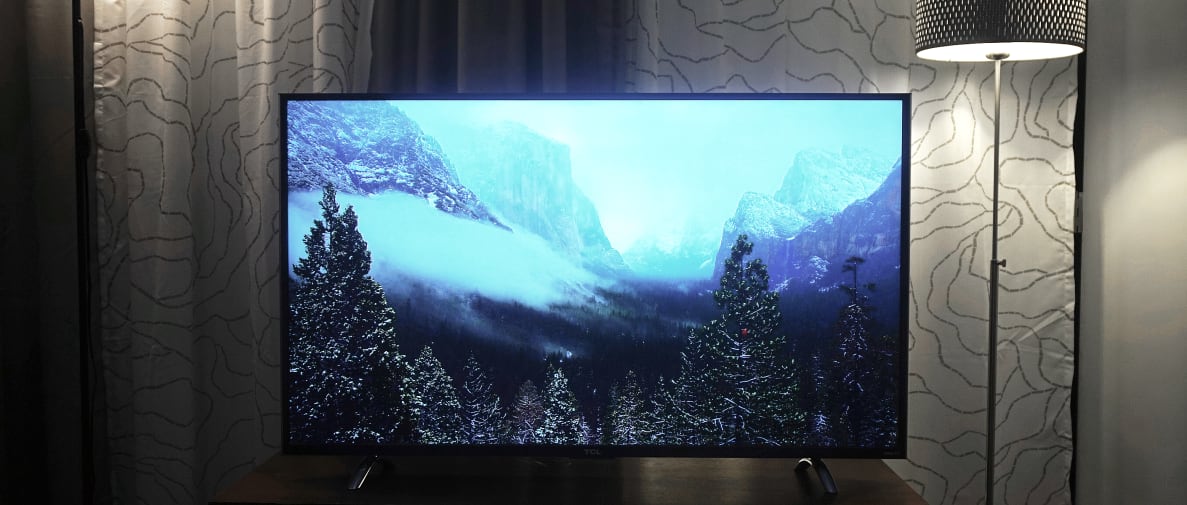The UP130 series comes in three screen sizes, but each of them offers a similar range of specs: 4K resolution, native 60 Hz refresh rates, and built-in Roku functionality (including a remote with voice recognition). Starting at just $499 for the 43-inch, these TVs are also available for much less than their competition: Vizio's 2016 M-Series TV of the same size will cost you an additional $100. So what's the catch?
There isn't a catch, actually. TCL has crafted a perfectly good 4K TV at a great price, with one of the best smart platforms around baked right in. While it's not perfect—no budget TV ever is—the picture quality is definitely good enough for most viewers, and the built-in Roku platform works great most of the time.
There are some snags in the overall flow (and a few performance issues that will disappoint fans of specific kinds of content), but overall the UP130 is a serious deal.
About the UP120 & UP130 series
TCL's 4K Roku-ready UP130 TV series is available in three different screen sizes:
{{ amazon name="TCL 50UP130 50-Inch 4K Ultra HD Roku Smart LED TV (2016 Model)", asin="B01C6XHQR8", align="right" }}
43UP120: 43-inch 4K Roku TV, MSRP TBD 43UP130: 43-inch 4K Roku TV, MSRP $449.99 50UP120: 50-inch 4K Roku TV, MSRP TBD 50UP130: 50-inch 4K Roku TV, MSRP $549.99 55UP120: 55-inch 4K Roku TV, MSRP $599.99 55UP130: 55-inch 4K Roku TV, MSRP $640.99
The UP120 and UP130 series TVs all come with the Roku smart platform, identical specs, and identical styling. The only discernible difference is the UP120 TVs come with the basic Roku remote while the UP130 TVs (like the 50UP130 that we tested for this review) have the advanced Roku remote with a headphone jack. The UP130 is widely available at multiple retailers like Best Buy and Amazon, while the UP120 series appears to be exclusive to shopping club retailers such as Costco and BJ's, though only the 55UP120 has made an appearance so far.
Here's the core specs for the UP120 and UP130 series:
• 4K resolution (3,840 x 2,160) • Built in Roku 4 platform w/ Roku remote • Direct LED backlighting • 4 HDMI, 1 USB • Roku app compatible
I spent about a week with the 50-inch UP130, which Reviewed.com received on-loan from TCL. The TV was a new production model that had never been used before, and we performed a full reset prior to testing and evaluation. We expect performance to be near-identical between all the models in both the UP120 and UP130 series.
What We Like
The built-in Roku platform is a familiar, simple solution. Where internet-connected smart TVs are concerned, there are a few different ways to handle built-in apps and web browsing. Platforms like LG's webOS-based smart TV platform or Samsung's Tizen-based smart TV platform are proprietary, and built from scratch. The other option is to incorporate a third party to do the heavy lifting, and that's the case with the UP120 and UP130.
But unlike other third-party smart platform partners—like Firefox or Google—Roku already bundles and sells the whole Roku experience as a separate for-TV product. Building that experience right into a TV is the next logical step, as it further simplifies Roku's plug-and-play app ecosystem. As you might expect, the UP120/UP130 series benefits greatly not only from Roku's presence as its smart platform, but from the lack of some other option cobbled together to do the job.
{{ photo_gallery "roku platform" }}
The result is a combination of TCL's display craftsmanship and Roku's understanding that user experience is the company's entire livelihood. If you like to wade through options and settings making a bunch of tweaks to suit your taste, this solution may not be for you. But if you just want a 4K TV with a super-simple way to watch 4K content on it, this line of TCL Roku TVs is a great jumping off point.
Case in point, it took about 10 minutes from first turning the TV on to watching 4K content on Netflix. Now that's convenient.
The TV's design is simple, but it's easy on the eyes. Considering the built-in bargain of 4K resolution with the Roku platform, the UP130's starting (online) price of $499 for the 43-inch is worth whistlin' about, so I wasn't expecting much by way of design—basically, I thought it would look/feel super cheap, but I was wrong.
{{ photo_gallery "design" }}
Our 50-inch test unit isn't going to win any best-dressed awards, but it's not a bad-looking TV. The UP120/UP130 series wields two caltrop-shaped silver feet. They're just plastic, but they complement the otherwise unremarkable charcoal-colored chassis. The bezels around the screen are nice and thin, and the TV strikes a handsome profile from the side. Because it doesn't use any premium materials, it's also light enough to easily pick up and reposition.
The TCL UP120 and UP130 series boast excellent shadow production for an LED TV. Regardless of whether you have 1080p or 4K resolution, black level (or shadow tone) is still one of the most important aspects of picture quality. Not only do darker black levels make TV/movie watching more immersive, the screen contrast makes bright highlights and colors that much more splendid and rich.
In the TV's Movie mode, I measured a really commendable black level of 0.036 nits, which is excellent for an LED TV in this price range. The corresponding brightness was a pretty standard 136.4 nits, which gives a static contrast of a little under 4000:1. You can expect way more brightness with the backlight turned up or in Vivid mode, but overall this is a great result for the price, and it looks great in the average living room.

For this price range, the UP130 delivers really solid black levels and decent overall contrast.
You get plenty of 4K-ready HDMI inputs. One big problem we've seen with "budget" 4K sets in the past is that they sometimes skip on the full hardware and connectivity options (like 4K-compatible HDMI inputs). It's the kind of setup that assumes you'll be streaming in 4K and won't be concerned about 4K Blu-ray or other separate devices. But you know what they say about assuming.
Fortunately, the UP120/UP130 Roku TVs are fully kitted out. The 50-inch is fitted with four HDMI 2.0 (4K capable) and HDCP 2.2 (4K disc playback) inputs, as well as one with ARC (Audio Return Channel) capabilities. Just note that it doesn't have a USB 3.0 port, so you'll have trouble playing your own digital 4K movies via USB.
The overall picture quality here is good enough for most people. The 50UP130 we tested has a lot of little picture quality errors—which are detailed in the next section—but overall it's not a bad-looking TV for the price. The contrast, color production, grayscale (neutral tone) accuracy, and motion all fall within the "good enough" category. You probably wouldn't want to move to this one from a very premium TV, but if your standards aren't super high, there won't be anything about the picture you take much issue with.
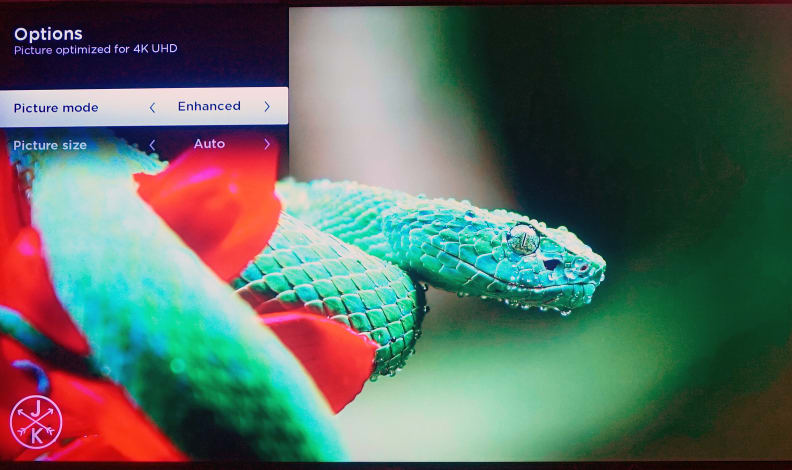
The UP130 isn't the best performer we'll see this year, but its got the forward-facing 4K resolution and color/contrast chops to please most viewers.
Of course, it's worth noting that standard performance benchmarks are quickly being outpaced by a lot of the year's other sets, all of which are pushing for wider color ranges and much higher luminance in the pursuit of High Dynamic Range, which is transforming what I'd call "good enough." Even still, taken as a standard set, the UP120 and UP130 look just fine.
The Roku remote mostly works like a charm. One of the best things about this TV—besides the Roku 4 platform—is the included remote, which is functionally identical to the Roku 4 remote, minus that now defunct Rdio button.
While familiarity with Roku's remote control was definitely a plus, I can't imagine anyone—from tech-savvy to technophobe—having any trouble with this one. While a couple of the keys are a little weird at first (there's both a "back" arrow and a "reverse circle" arrow), the layout is very intuitive. Punching in user accounts and passwords was easy thanks to the quick key travel.
Finally, the ability to plug a headset into the remote control so you can listen to private audio without disturbing anyone else is a really nice touch. This is a standard function for the full Roku boxes, but having it with a TV is extra cool. The voice search doesn't always work in a completely snag-free manner, though—more on that in a minute.
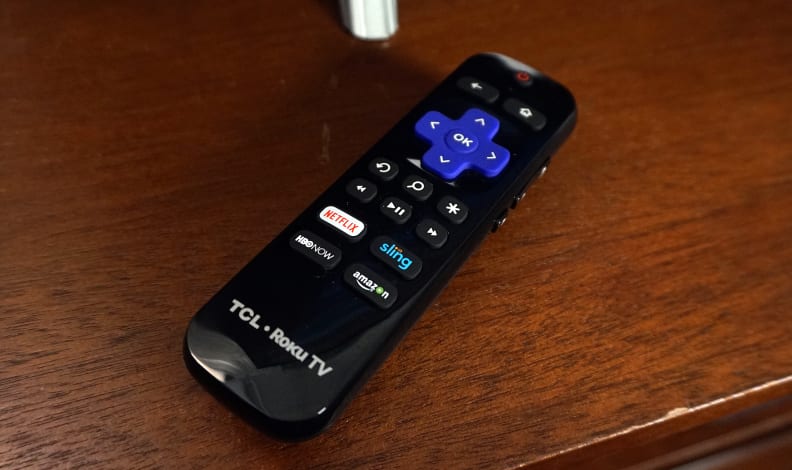
The included remote still delivers the standard Roku volume buttons (on the right side), a headphone jack for private listening (on the left side), and dedicated app buttons at the button. The Rdio button from the Roku 4 box has been replaced by HBO Now.
What We Don't Like
For all its ease of use, the Roku platform here isn't totally free of snags.
• Who It Affects: All viewers, unless you don't plan on using the Roku features
My initial experience with the 50-inch TCL 50UP130 was great. Setup took about 10 minutes, and then I was watching Moving Art: Waterfalls in 4K on Netflix. Buffering was quick and painless, and the content looked pretty good—but more on the picture quality in a moment.
Afterwards, I tried to go back and watch something else. Netflix threw an error, and I was kicked back to the home menu. I tried YouTube next, and chose some video footage of Costa Rican wildlife at 4K/60fps. The content took a little longer than normal to ratchet up to 4K resolution, but looked fine once it got there, though at one point the whole TV froze up and I had to start the video over.
I also found the voice search functionality to be a bit lacking. I searched multiple times for "Breaking Bad," and got results for "baking" and "freaking," eventually being told the voice system just couldn't understand me at all. I'm not the most eloquent speaker, but I can annunciate when I need to. On the other hand, I had plenty of success in other areas. Overall the voice system—which is a great idea on paper—isn't fatally flawed, but it's not as snappy and reliable as I'd like.
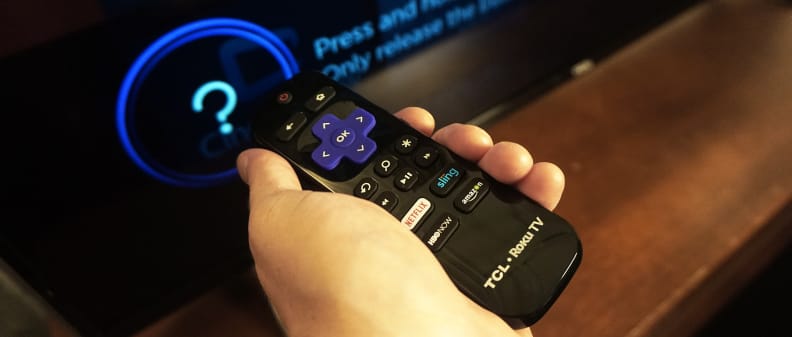
The Roku platform mostly works as advertised, but I encountered quite a few small snags or operation issues that made the experience a little less than stellar.
The UP130's backlight uniformity isn't reliable.
• Who It Affects: Picky viewers, anyone who wants to use the TV as PC monitor
Before doing any testing with patterns or meters, I sat down and just watched content with the intent to enjoy some high-rez 4K—as I imagine anyone would when getting a new 4K TV. The UP130 looks a lot better upon first glance than some of last year's sets, but I was able to pick out some issues right away.

Every now and again, when most of the screen is a similar color or luminance level, attentive viewers may notice discrepancies or spaces in the backlight LED coverage.
For example, the TV is a Direct LED TV—meaning it has LEDs behind the entire screen—but the backlight array isn't always even even. This is a "uniformity" issue, and it's one of the first things I noticed. Bands of space between the LEDs are sometimes dimmer than ideal, making for dark strips that are visible when most of the screen is the same color/luminance, such as during a scene with lots of sky or clouds.
This isn't just something you'll see in a dedicated dark-room viewing environment, either. I watched with a few lamps on (and windows near) and could still see darkening/lightening at the edges of the screen and amongst clouds rolling by during some 4K Netflix content.
This TV doesn't have any of the standard motion settings.
• Who It Affects: Sports fans, action movie buffs, film buffs
These days, most TVs have some form of motion smoothing or motion assistance. You may have even seen this kind of interpolation called the "Soap Opera Effect" because of how it can make TVs look when used injudiciously. However, when used properly, de-blur modes (for fast-action content, like sports) and de-judder/telecine modes (to allow for 24fps Blu-ray playback) are a boon to any TV.

Because it's capped at 60 Hz, the UP130 doesn't always do a perfect job rendering 24p Blu-ray content, and won't be able to smooth out fast-action content, like sports.
The TCL UP130 doesn't have these modes, however. It's a 60 Hz TV, which is the standard refresh rate, but it also means it can't interpolate frames or properly render 24fps (due to 24 not multiplying into 60, essentially). While most cable/Netflix/YouTube content is going to play fine on a 60Hz TV, film buffs who have a collection of Blu-rays aren't going to be elated by this prospect.
For example, I watched a particularly tricky sweeping scene from the first Lord of the Rings Blu-ray, one with a lot of horizontal/vertical panning of dark lines against a static background, and the TV really couldn't render it without visible judder. While this is a scene that's difficult for almost every 60 Hz TV, it's worth noting if you watch a lot of Blu-rays.
TCL only included the most basic picture controls.
• Who It Affects: Videophiles
This one's a minor complaint, but it's worth mentioning that if you're a picture quality nut and your plan is to get a nice, affordable TV and then calibrate it to make it look professional, you're going to be out of luck. Only the basic controls such as backlight, brightness, color, tint, and sharpness can be adjusted—you won't find any way to tweak the color accuracy or grayscale tracking.
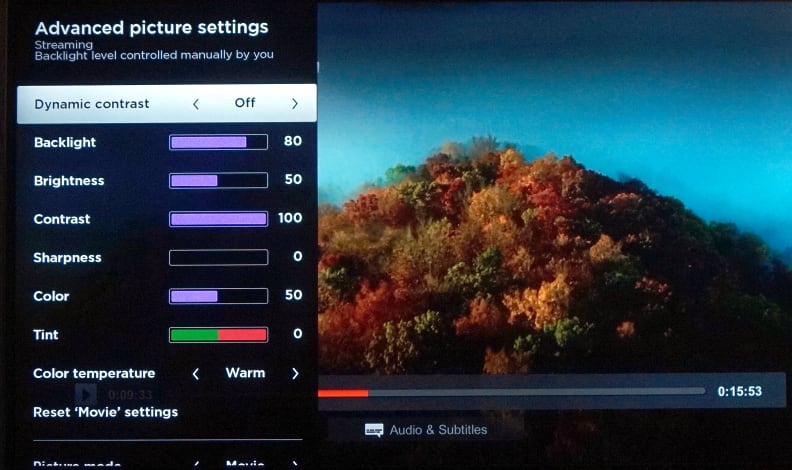
Because the UP130 only has a few basic picture adjustments, you won't be able to perform a fine-tuning calibration for things like color accuracy or white balance.
This is a "next-gen" TV in 4K resolution only.
• Who It Affects: Buyers looking to future-proof
The UP130's basic picture performance—contrast, color range—is pretty rock-solid for the price you're paying, but it falls a bit behind some of the "UHD" TVs we've tested recently. Unlike the Sony X930D or last year's Samsung JU7100, the UP130 only promises "standard" levels of color and contrast, and won't play HDR (High Dynamic Range) content at all.
While this TV has an "Enhanced" picture mode that's designed for Ultra HD content (presupposing things like wide color gamut and 10-bit chromatic resolution), it's really just a more fancy "Vivid" or "Dynamic" mode, pushing the TV's color and brightness to max levels at the expense of subtlety and balance. It doesn't look bad, but it also doesn't look like a true next-generation, HDR-capable TV.

The UP130 has an "Enhanced" picture mode meant for 4K/UHD content. It adds extra color and some extra brightness, but isn't a true HDR mode.
Should You Buy It?
Yes—if you just want a 4K TV that works as advertised.
the If you want a super-convenient 4K TV and don't care about certain fancy extras, the TCL UP120 and UP130 series are an awesome choice. The series are practically identical and both are a great value. The downside? The picture quality isn't on the level with the year's priciest TVs, and you won't get forward-facing features like HDR compatibility, tons of extra color, or even some of the basic options like motion smoothing. But taken in terms of core performance and the robust, reliable Roku platform, both the UP120 and UP130 series provide a feature-rich, budget-friendly way to get a big-screen 4K TV without spending a bundle.
The final takeaway is that if you're really prioritizing 4K resolution, I'd shoot for either the 50-inch (50UP130 or 50UP120) or 55-inch (55UP130 or 55UP120) models. At 43 inches, the smallest size may not be quite big enough for the 4K resolution to matter unless you're sitting super close. I'd also personally opt for the UP130 series. They're the same as the UP120 models, but the advanced Roku remote is just slightly better—assuming the cost difference isn't astronomical. The TCL Roku UP130 is a solid standard performer, but it doesn't take aim at the loftier goals set by the High Dynamic Range standard. However, for what you're paying, this one is a very reliable performer with only a handful of flaws that might discourage a small percentage of viewers.
Testing revealed accurate colors, high contrast, even emphasis of RGB tracking, and color-free grayscale—a good balance of quality that will make most content look good.
On the other hand, picky viewers make take issue with the TV's lower-end 60 Hz locked refresh rate, which properly render Blu-rays that play back at 24 frames per second.
The TV also exhibited some backlight uniformity issues, specifically with regard to vertical rows of LEDs, where full-field colors or grayscale elements sometimes appear uneven.
But outside of these small issues, the UP130 doesn't have too many picture quality-related flaws to speak of, and that's a great result.
We didn't calibrate this one because the controls simply aren't there to do an extensive, in-depth calibration.
However, the TV's Movie mode is extremely accurate by rec.709 standards, which you'll discover below.
Color Accuracy
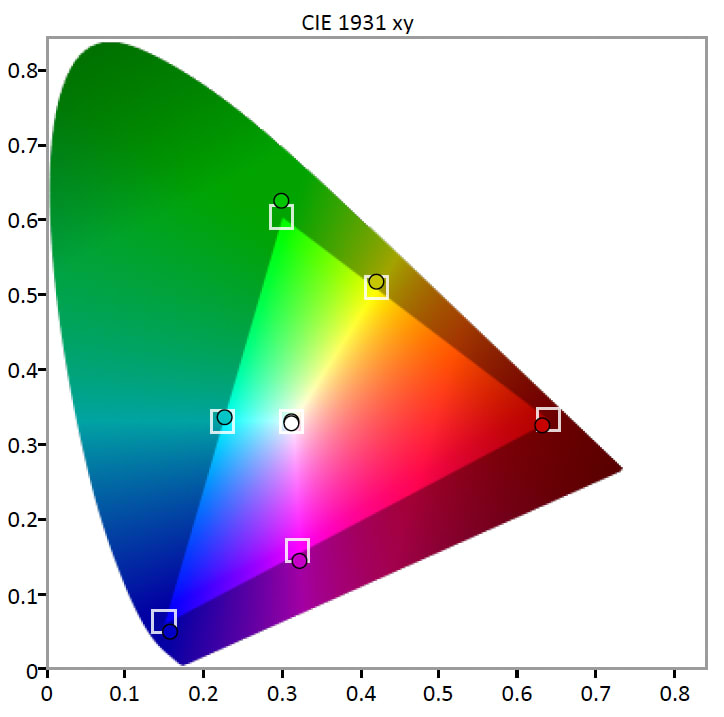
When displaying rec.709/standard color sources (anything not HDR), the UP130 exhibits extremely good color accuracy, with just a little extra green for increased luminance performance.
Grayscale Accuracy
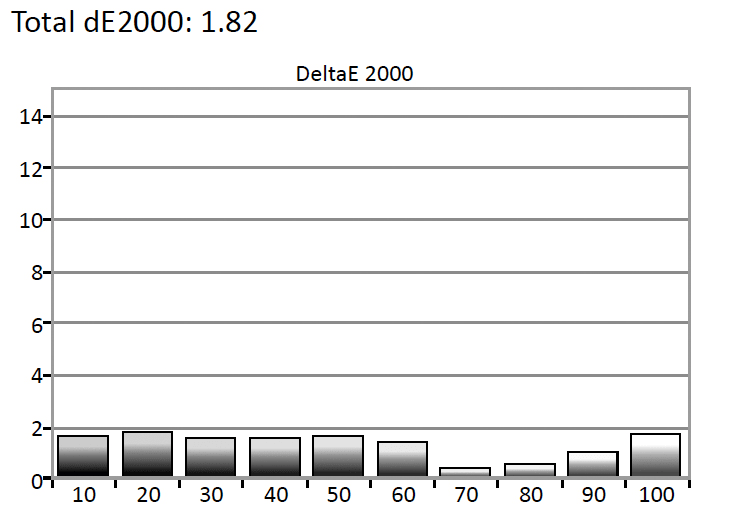
The UP130 tested with a total grayscale delta E (max error) of 1.82, which is an awesome result. Any dE lower than 3 is imperceptible to human eyes.
RGB Emphasis
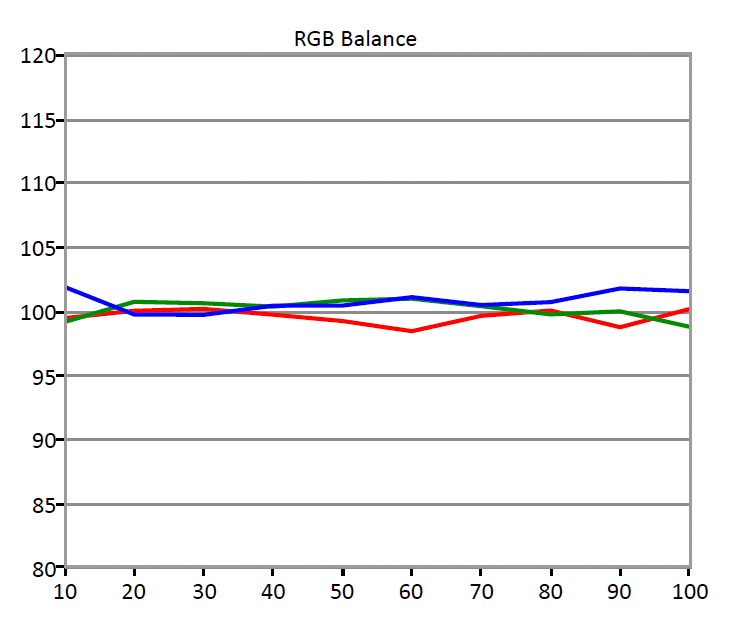
As we expected based on the grayscale delta E performance, the UP130 boasts a very tight RGB balance, with only mild aberrations in overall emphasis from dark to bright.
Gamma Curve
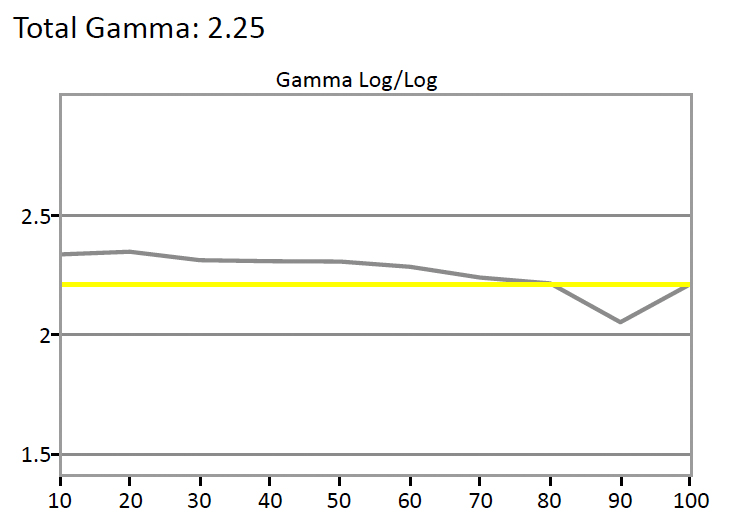
The UP130 tested with a fairly flat gamma curve of 2.25, which compares favorably for an out-of-box Movie mode, which should sit around 2.2 or 2.3. There's a bit of a snag around 90 IRE, but nothing too egregious.
Meet the testers
Mark Brezinski works on the Home Team, reviewing refrigerators, minifridges, dishwashers, washing machines, dryers, air conditioners, air purifiers, and fans.
Lee was Reviewed's point person for most television and home theater products from 2012 until early 2022. Lee received Level II certification in TV calibration from the Imaging Science Foundation in 2013. As Editor of the Home Theater vertical, Lee oversaw reviews of TVs, monitors, soundbars, and Bluetooth speakers. He also reviewed headphones, and has a background in music performance.
Checking our work.
Our team is here to help you buy the best stuff and love what you own. Our writers, editors, and experts obsess over the products we cover to make sure you're confident and satisfied. Have a different opinion about something we recommend? Email us and we'll compare notes.
Shoot us an email
